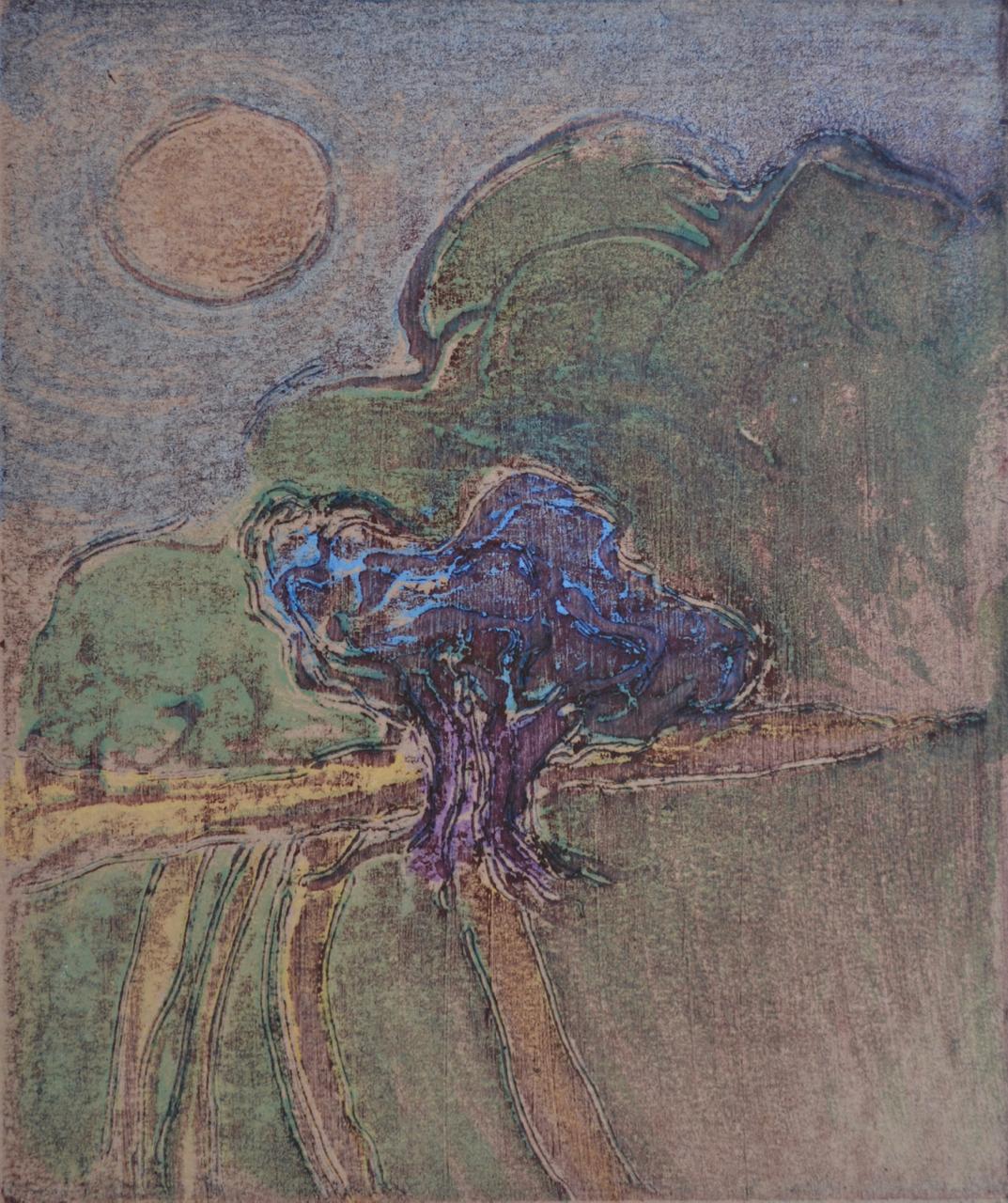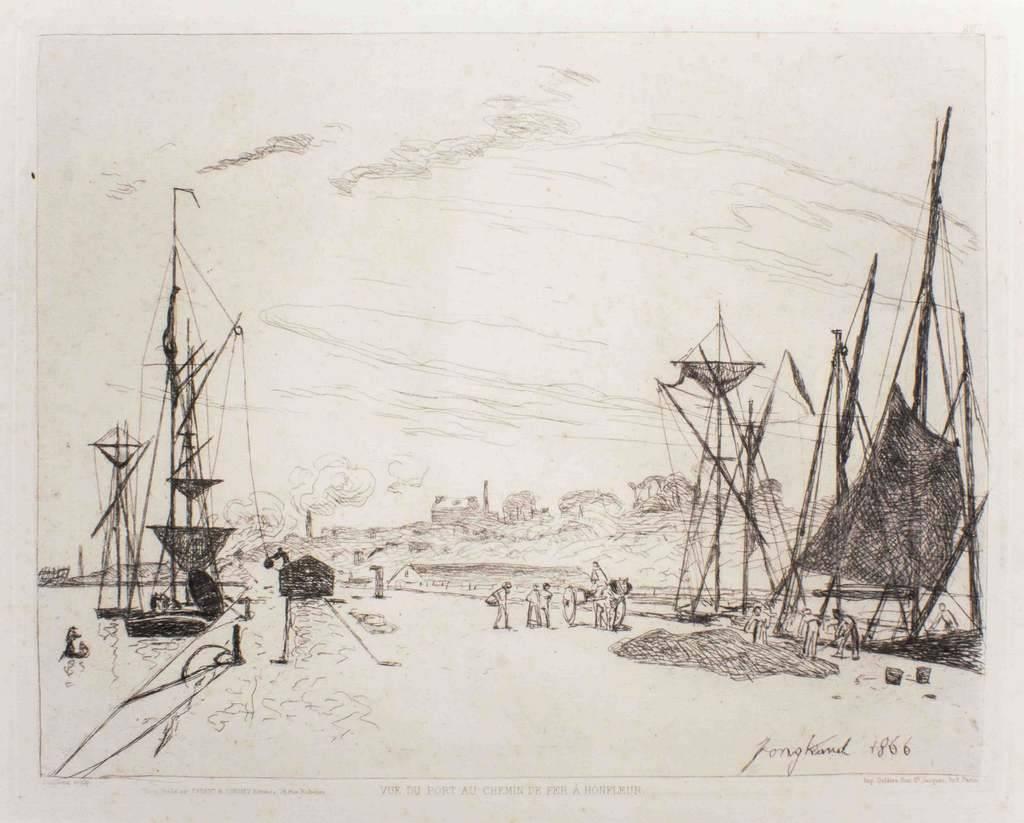Camille PissarroLa rentrée du Berger by Camille Pissarro - Etching1889
1889
About the Item
- Creator:Camille Pissarro (1831-1903, French)
- Creation Year:1889
- Dimensions:Height: 3 in (7.6 cm)Width: 4.3 in (10.9 cm)
- Medium:
- Movement & Style:
- Period:
- Condition:
- Gallery Location:London, GB
- Reference Number:1stDibs: LU261214154482
Camille Pissarro
Camille Pissarro was one of the most influential members of the French Impressionist movement and the only artist to participate in all eight Impressionist exhibitions.
Born in July of 1830 on the island of Saint Thomas in the Danish West Indies, Camille was the son of Frédéric and Rachel Pissarro. At the age of 12, he went to school in Paris, where he displayed a penchant for drawing. He returned again to Paris in 1855, having convinced his parents to allow him to pursue a career as an artist rather than work in the family import/export business. Camille studied at the Académie Suisse alongside Claude Monet, and, during this time, he met Paul Cézanne, Édouard Manet and Pierre-Auguste Renoir.
In 1869, Camille settled in Louveciennes. The outbreak of the Franco-Prussian War in 1870 prompted him to move to England, and, with Monet, Camille painted a series of landscapes around Norwood and Crystal Palace, while studying English landscape painting in the museums. Upon returning a year later at the end of the War to Louveciennes, Camille discovered that only 40 of his 1,500 paintings — almost 20 years’ work — remained undamaged.
Camille settled in Pontoise in the summer of 1871, remaining there and gathering a close circle of friends around him for the next 10 years. He reestablished relationships with Cézanne, Manet, Monet, Renoir and Edgar Degas, expressing his desire to create an alternative to the Salon, so that their group could display their own unique styles. Camille married Julie Vellay, with whom he would have seven children. Cézanne repeatedly came to stay with them, and, under Camille’s influence, he learned to study nature more patiently, even copying one of Camille’s landscapes in order to learn his teacher’s technique.
The first Impressionist group exhibition, initiated by Monet in 1874, earned the Impressionists much criticism for their art. While mainly interested in landscape, Camille introduced people — generally, peasants going about their rural occupations — and animals into his works, and they often became the focal point of the composition. It was this unsentimental and realistic approach, with the complete absence of any pretense, which seemed to stop his work from finding appreciation in the general public.
One of the few collectors who did show interest in Camille’s work was a bank employee named Paul Gauguin, who, after acquiring a small collection of Impressionist works, turned to Camille for advice on becoming a painter himself. For several years, Gauguin closely followed his mentor, and, although their friendship was fraught with disagreement and misunderstandings, Gauguin still wrote shortly before Camille’s death in 1906: “He was one of my masters, and I do not deny him.”
In the 1880s, Camille moved from Pontoise to nearby Osny, before Eragny, a small village much further from Paris. At a time when he was dissatisfied with his work, in 1885, Camille met both Paul Signac and Georges Seurat. He was fascinated by their efforts to replace the intuitive perceptive approach of the Impressionists with a “Divisionist” method, or scientific study of nature’s phenomena based on optical laws. Despite having reached his mid-50s, Camille did not hesitate to follow the two young innovators. The following year, he passed on this new concept to Vincent Van Gogh, who had just arrived in Paris and was keen to learn of the most recent developments in art. However, after a few years, Camille felt restricted by Seurat’s theories and returned to his more spontaneous technique while retaining the lightness and purity of color acquired during his Divisionist phase.
In the last years of his life, Camille divided his time between Paris, Rouen, Le Havre and Eragny, painting several series of different aspects of these cities, with varying light and weather effects. Many of these paintings are considered among his best and make for an apt finale to his long and prodigious career.
When Camille Pissarro died in the autumn of 1903, he had finally started to gain public recognition. Today his work can be found in many of the most important museums and collections throughout the world.
Find original Camille Pissarro art on 1stDibs.
(Biography provided by Stern Pissarro Gallery)
- ShippingRetrieving quote...Ships From: London, United Kingdom
- Return PolicyA return for this item may be initiated within 7 days of delivery.
- Effet de pluie by Camille Pissarro - Landscape etchingBy Camille PissarroLocated in London, GBEffet de pluie by Camille Pissarro (1830-1903) Etching, aquatint and drypoint 15.9 x 21.3 cm (6 ¹/₄ x 8 ³/₈ inches) Stamped with initials C.P. lower left and numbered 7/14 lower righ...Category
1870s Impressionist Landscape Prints
MaterialsDrypoint, Etching, Aquatint
- Series - South of France by Lélia Pissarro, SerigraphBy Lelia PissarroLocated in London, GBSeries - South of France by Lélia Pissarro (B. 1963) Serigraph Image Size: 38 x 48 cm (15 x 19 inches) Sheet Size: 48 x 59 cm (18 ⅞ x 23 ¼ inches) Signed and numbered Printed in an edition of 300 SOLD UNFRAMED Artist's Biography Born in Paris in 1963, Lélia is the third and youngest child of Hugues-Claude and Katia Pissarro...Category
21st Century and Contemporary Impressionist More Prints
MaterialsScreen
- Jardin de la Villa à Brantôme by Paulémile Pissarro - Etching PrintLocated in London, GB*UK BUYERS WILL PAY AN ADDITIONAL 20% VAT ON TOP OF THE ABOVE PRICE Jardin de la Villa à Brantôme by Paulémile Pissarro (1884 - 1972) Etching 20.5 x 28.5 cm (8 ⅛ x 11 ¼ inches) Sign...Category
20th Century Landscape Prints
MaterialsEtching
- Veronique on the Pass by Lélia Pissarro - Coloured etchingBy Lelia PissarroLocated in London, GBVeronique on the Pass by Lélia Pissarro (b. 1963) Coloured etching 9.5 x 12 cm (3 ³/₄ x 4 ³/₄ inches) Signed lower left, Lélia Pissarro Numbered lower right, 1/15 Artist biography: Born in Paris in 1963, Lélia is the third and youngest child of Hugues-Claude and Katia Pissarro...Category
21st Century and Contemporary Landscape Prints
MaterialsColor, Etching
- Le Village de Landel by Paulémile Pissarro - etchingLocated in London, GBSOLD UNFRAMED Le Village de Landel by Paulémile Pissarro (1884 - 1972) Etching 17.2 x 23.7 cm (6 ¾ x 9 ⅜ inches) Signed lower right, Paulémile-Pissarro and numbered lower left, 2e e...Category
20th Century Post-Impressionist Landscape Prints
MaterialsEtching
- Series - Monet's House by Lélia Pissarro - ScreenprintBy Lelia PissarroLocated in London, GBSeries - Monet's House by Lélia Pissarro (B. 1963) Serigraph 38 x 48 cm (15 x 18 ⁷/₈ inches) Signed and numbered Printed in an edition of 300 Artist's Biography: Born in Paris in 19...Category
21st Century and Contemporary Post-Impressionist More Prints
MaterialsScreen
- The Reaper : Life and Death - Original etching - Ed. Durand Ruel, 1873By Pierre Puvis de ChavannesLocated in Paris, FRPierre PUVIS DE CHAVANNES (after) The Reaper : Life and Death, 1873 Original Etching Engraved by Boilvin under the supervision of PUVIS DE CHAVANNES Printed signature in the plate On laid paper 20,5 x 30 cm (c. 8 x 12 in) INFORMATION : This etchings was edited in 1873 by Galerie Durand Ruel...Category
1870s Impressionist Landscape Prints
MaterialsEtching
- Mounts Bay Mood. Contemporary limited edition etchingBy Ian LaurieLocated in Brecon, PowysMounts Bay Mood. Limited Edition etching from the well collected studio of Ian Laurie. Signed and numbered 14 of 50. Each one of the 25 is slightly different in tone and color Image...Category
21st Century and Contemporary Impressionist Landscape Prints
MaterialsEtching
- Lonely Giant. Contemporary Limited Edition EtchingBy Ian LaurieLocated in Brecon, PowysLimited Edition , 5 of 15, etching from this very collected Scottish artist. Signed. Excellent condition Image 9" x 7.5" Ian Laurie was born in 1933 and is a self taught artist who...Category
21st Century and Contemporary Impressionist Landscape Prints
MaterialsEtching
- Provence : Sainte Victoire Mountain - Etching and aquatint engraved by J. VillonBy Paul CézanneLocated in Paris, FRPaul CÉZANNE (after) Provence : Sainte Victoire Mountain Etching and aquatint Engraved by Jacques Villon after the painting of Cezanne Signature printed in the plate On Arches vellu...Category
1950s Impressionist Landscape Prints
MaterialsEtching, Aquatint
- Vue du Port au Chemin de Fer à HonfleurBy Johan Barthold JongkindLocated in Roma, ITSigned on plate. Plate: 267 Image Dimensions : 24 x 34 cm This artwork is shipped from Italy. Under existing legislation, any artwork in Italy created over 70 years ago by an arti...Category
1860s Impressionist Landscape Prints
MaterialsEtching
- The Angelus - Original etching - Ed. Durand Ruel, 1873By Jean François MilletLocated in Paris, FRJean Francois MILLET (after) The Angelus, 1873 Original Etching Engraved by Martinez under the supervision of PUVIS DE CHAVANNES Printed signature in the ...Category
1870s Impressionist Landscape Prints
MaterialsEtching



